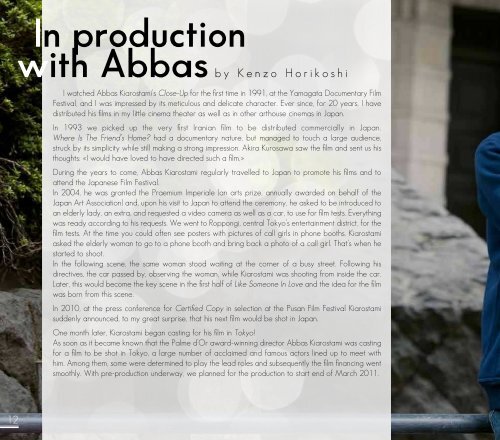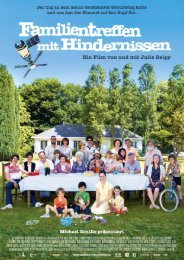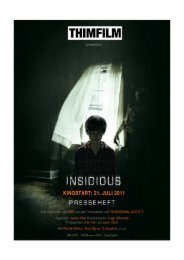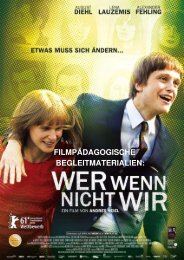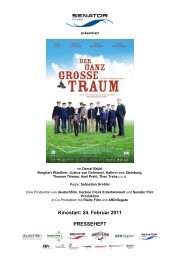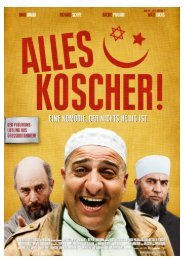Abbas Kiarostami - Thimfilm
Abbas Kiarostami - Thimfilm
Abbas Kiarostami - Thimfilm
- No tags were found...
Create successful ePaper yourself
Turn your PDF publications into a flip-book with our unique Google optimized e-Paper software.
In productionwith <strong>Abbas</strong> by Kenzo HorikoshiI watched <strong>Abbas</strong> <strong>Kiarostami</strong>’s Close-Up for the first time in 1991, at the Yamagata Documentary FilmFestival, and I was impressed by its meticulous and delicate character. Ever since, for 20 years, I havedistributed his films in my little cinema theater as well as in other arthouse cinemas in Japan.In 1993 we picked up the very first Iranian film to be distributed commercially in Japan.Where Is The Friend’s Home? had a documentary nature, but managed to touch a large audience,struck by its simplicity while still making a strong impression. Akira Kurosawa saw the film and sent us histhoughts: «I would have loved to have directed such a film.»During the years to come, <strong>Abbas</strong> <strong>Kiarostami</strong> regularly travelled to Japan to promote his films and toattend the Japanese Film Festival.In 2004, he was granted the Praemium Imperiale (an arts prize, annually awarded on behalf of theJapan Art Association) and, upon his visit to Japan to attend the ceremony, he asked to be introduced toan elderly lady, an extra, and requested a video camera as well as a car, to use for film tests. Everythingwas ready according to his requests. We went to Roppongi, central Tokyo’s entertainment district, for thefilm tests. At the time you could often see posters with pictures of call girls in phone booths. <strong>Kiarostami</strong>asked the elderly woman to go to a phone booth and bring back a photo of a call girl. That’s when hestarted to shoot.In the following scene, the same woman stood waiting at the corner of a busy street. Following hisdirectives, the car passed by, observing the woman, while <strong>Kiarostami</strong> was shooting from inside the car.Later, this would become the key scene in the first half of Like Someone In Love and the idea for the filmwas born from this scene.In 2010, at the press conference for Certified Copy in selection at the Pusan Film Festival <strong>Kiarostami</strong>suddenly announced, to my great surprise, that his next film would be shot in Japan.One month later, <strong>Kiarostami</strong> began casting for his film in Tokyo!As soon as it became known that the Palme d’Or award-winning director <strong>Abbas</strong> <strong>Kiarostami</strong> was castingfor a film to be shot in Tokyo, a large number of acclaimed and famous actors lined up to meet withhim. Among them, some were determined to play the lead roles and subsequently the film financing wentsmoothly. With pre-production underway, we planned for the production to start end of March 2011.But then disaster struck. On March 11, Japan was hit by the mostpowerful earthquake it had experienced since 1900 and the tsunamicaused considerable damage to the country’s East Coast. From then on,all films in production, including ours, were interrupted or held back untila future date. The financing partners abandoned all their film projects.Hoping to for a fresh start in May, we realized that our lead actorswere no longer available for rehearsals. Once again, we had to setup a new casting process. After a few months of casting, the ensemblewas finally confirmed, and apart from the actor Ryo Kase, none of thelead actors were known to film fans. <strong>Kiarostami</strong>’s remarkable intuitionallowed us to lock down a cast, in line with the characteristic cast ofhis films.The production finally got under way on October 30 2011beginning with the first scene of the screenplay written by <strong>Kiarostami</strong>:FIRST SCENE - CAFÉ - NIGHT TIME.But again we suffered a setback. A couple of days later, all the extraswere replaced and the scene was shot again. As expected, <strong>Kiarostami</strong>’sdirection was completely unique. He would not allow the actors toread the entire screenplay. Every day, the details of the scene to beshot the following day were revealed to the actors. They did not knowtheir characters’ role in the story, nor did they know how the film ends.To know the end of the story and the fate of the characters couldlead to the actors counter-performing, a sort of «performance with adowngrading effect».I don’t believe that <strong>Kiarostami</strong> is limiting the actor’s liberty, but that he12 13


